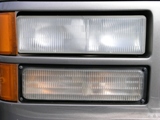|
|
 |
| |
OXIDATION-THE ROOT OF THE PROBLEM
Since the early 1990's, cars and trucks have been manufactured with acrylic (plastic) lenses, essentially molded covers over the actual light bulbs.
The manufacturer's knew that ultra violet (u.v.) would damage the plastic, so they put a sacrificial u.v. inhibitor coating on the lens. Not a very good coating. Their position is that this is a maintenance issue, without giving much direction as to what kind of maintenance, let alone how often.
We all know this, regular washing does not help. Nor does scrubbing, in fact hard scrubbing can hurt your lens.
|
| |
This u.v. layer is sacrificial, it degrades over time. The process is oxidation, quite like rusting. This causes the 'hazing' or 'fogging' effects. As the plastic oxidizes it becomes coarse with large openings, which allows environmental pollutants to attach. Things like oil and salts, which causes the yellowing. This stain is very difficult to remove with ordinary maintenance. On the newer lights you may not see the oxidation process, the thin layer just starts to disappear, you can see the lines where the coating is gone. Heat from the lamp itself sometimes contribute to the degradation, as the surface temperatures can reach upwards to 160 degrees on some cars.
|
 |
So what is the solution? After quite a bit of research I found that there are some chemicals that can remove the staining and some of the oxidation, but the damage has already become permanent. Some of these headlights can be cleaned (deoxidized) to a better clarity, but the process will only be temporary and the cleaning will need to be done on a monthly basis. The light on the left can be cleaned but the cost and effort of continual maintenance is not a long term solution. The bulk of the lights, however, can not be cleaned, rather, they must be restored (refinished). It makes better economic sense to stop the damage and replace the factory coating with a dependable permanent crystal clear ultraviolet protective coating.
|
|
|
|
|
|
|